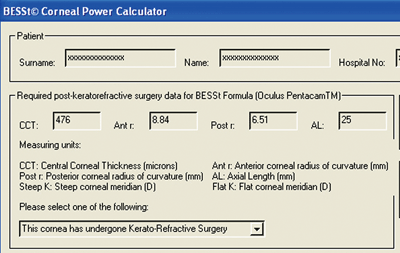The surgeon who developed the formula, Edmondo Borasio, did so while working as a fellow with Moorfields' Dr. Julian Stevens. Their names, along with Moorfields colleague Guy T. Smith, make up the BESSt acronym: Borasio Edmondo Smith and Stevens.

The BESSt formula needs no pre-refractive surgery data.
The BESSt formula is a modified version of a Gaussian optics formula, and was developed after studying 150 refractive surgery eyes.
To test the formula's accuracy with actual post-refractive surgery cataract patients, Dr. Borasio analyzed the outcomes of 13 patients, comparing target refractions calculated with the BESSt formula to those calculated with other methods. The average deviations between the target and achieved refractions were as follows:
• BESSt (0.08 ±0.62 D);
• Clinical history (-0.07 ±1.92 D; p=0.05);
• Clinical history with Double-K adjustment (0.13 ±2.39 D; p=0.05);
• Holladay 2 Formula using K-values from the hard contact lens over-refraction method
(-0.76 ±1.36 D; p=0.03);
• Holladay 2 Formula using K-values from the Atlas Topographer, (-0.55 ±0.61 D; p<0.01).
Though the two clinical history methods were close to the BESSt formula, Dr. Borasio notes that they both require pre-refractive surgery data (refraction and keratometry values), while the BESSt formula does not.
In order to perform corneal power calculations using the BESSt Power Calculator, the surgeon must know the cornea's anterior and posterior radii of curvature, as well as the central thickness. Dr. Borasio takes these values from the Oculus Pentacam, but he says that, theoretically, they could be acquired with an Orbscan and an ultrasonic pachymeter, though the accuracy of the formula wasn't tested with the Orbscan. For IOL power calculations, he recommends getting the axial length measurement with an IOL Master (Carl Zeiss Meditec), because he says A-Scan ultrasound is less accurate. The surgeon also must have the target postop refraction and the IOL's A-Constant.



